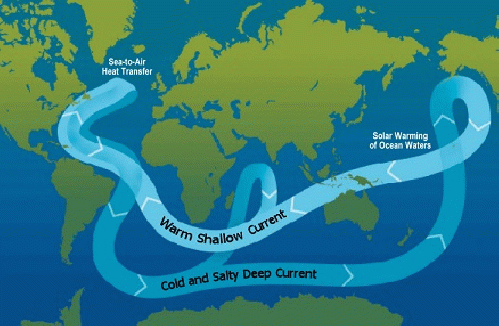But how can global warming provoke cooling in the eastern part of North America and across Europe?
The scenario was the plot basis (albeit wildly exaggerated) of the 2004 sci-fi film The Day After Tomorrow.
A deep ocean current sometimes called the Great Conveyor Belt (scientifically called the AMOC or Atlantic Meridional Overturning Circulation) brings warm South Pacific water down under the southern tip of Africa, and then up the east coast of South and North America (we call it the Gulf Stream) to western Europe. (Here's a video from NASA.)
This river of water -- larger in volume than all the land-based rivers in the world -- delivers millions of tons of warm water a minute to an endpoint just south of Greenland and west of the UK, where, as much of the heat from that water is lifted into the atmosphere to blow east and warm Europe, the now-cool and saltiest-sea-water-in-the-world (it loses moisture along with heat) sinks deep down toward the ocean floor to begin its multi-year-long journey back toward the South Pacific.
Because this system is driven by both temperature and the sudden increase in salinity as it loses heat in the North Atlantic, its driving system is called thermohaline (temperature-salt).
The reason London and Amsterdam, at latitudes similar to Calgary and Edmonton, have weather like that of Europe is an Atlantic Ocean current driven by heat and salt.

(Image by (From Wikimedia) Thomas Splettstoesser, Author: Thomas Splettstoesser) Details Source DMCA
And because the UK, Germany, the Netherlands, Poland, and all of Northern Europe and Scandinavia are at roughly the same latitudes as the area from central Canada to Alaska, the only thing that keeps them warm enough to sustain rich crop yields (unlike Alaska) is the heat distributed to them from the Great Conveyor Belt/AMOC.
And the main thing that keeps the AMOC moving is the incredible salinity that forms in the North Atlantic as the current gives up both heat and water vapor, (leaving behind the salt) into the soon-to-warm-Europe air with the warmth. Because the strongly saline water is so much denser/heavier than normal seawater, it sinks vigorously toward the deeper parts of the ocean, pulling the rest of the current behind it and helping maintain the AMOC's flow.
Should something begin to inject fresh water into that region, thus diluting the salinity of the AMOC there, it would reduce the density of that water column and thus could shut down the Conveyor Belt. And that would shut off Europe's main heat source.
This is a scenario that most climate scientists -- until this year -- considered a remote possibility, even in the next century.
But it's beginning to happen right now, both in Antarctica and off the coast of Greenland and Western Europe, because of massive glacier melts.
One part of the thermohaline circulation of the AMOC runs around Antarctica. And, because of global warming, Antarctica is shedding hundreds of billions of tons of ice-melt fresh water into the ocean every year -- which is diluting and cooling saltwater and reducing local thermohaline circulation.
As Chris Mooney notes in the 4/3/18 Washington Post ("One Of The Most Worrisome Predictions About Climate Change May Be Coming True"):
"The new research, based on ocean measurements off the coast of East Antarctica, shows that melting Antarctic glaciers are indeed freshening the ocean around them. And this, in turn, is blocking a process in which cold and salty ocean water sinks below the sea surface in winter, forming 'the densest water on the Earth'..."
Meanwhile, the northern part of the Great Conveyor Belt -- which warms Europe -- is also faltering in the North Atlantic, largely as a result of hundreds of billions of tons of cold, fresh water from Greenland glacier-melt, caused by global warming, pouring into it every few minutes.
(Note: You can view every article as one long page if you sign up as an Advocate Member, or higher).





